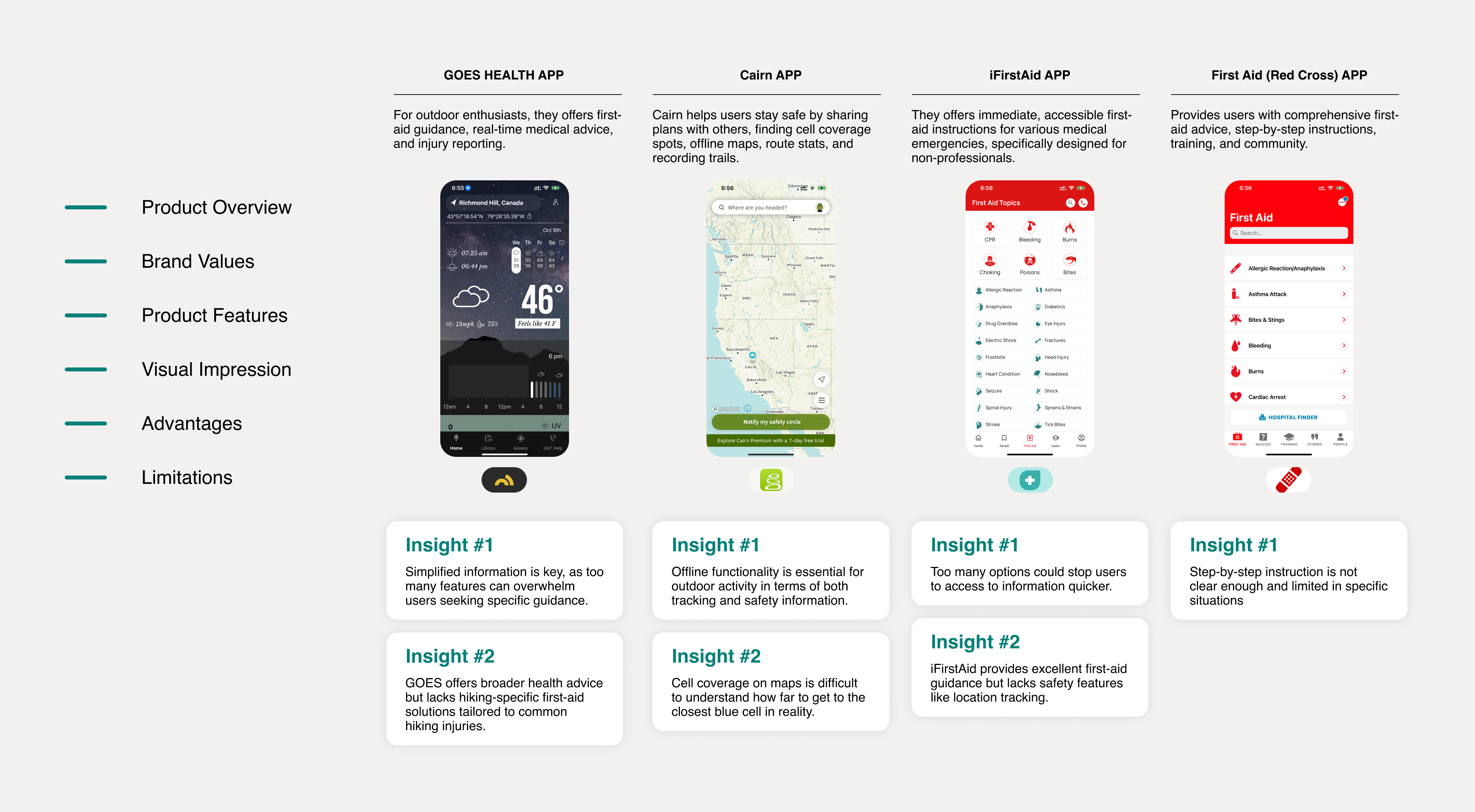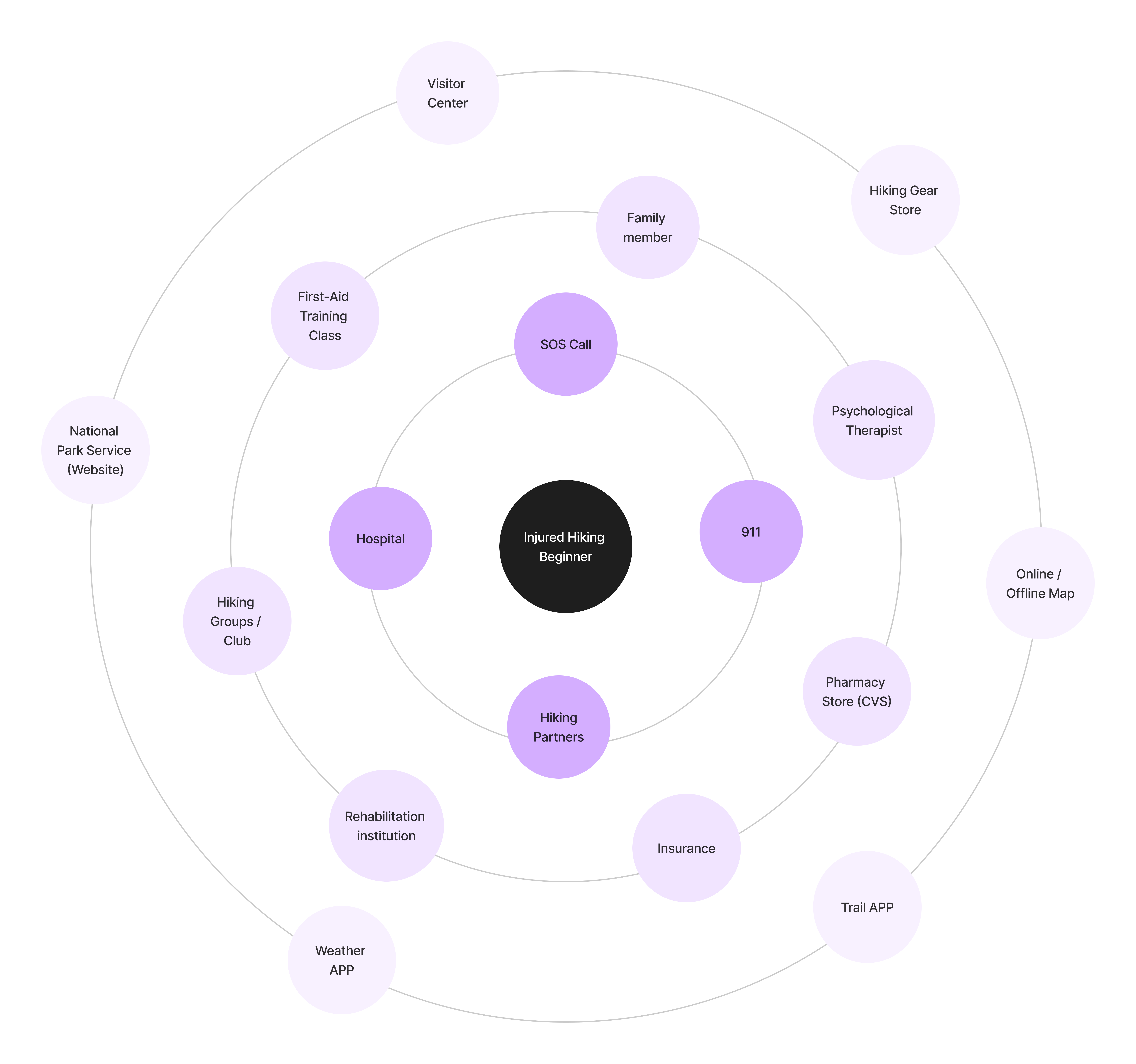


SAFIHIKE is an app dedicated to providing comprehensive and reliable hiking safety information, ensuring hikers' safety on the trail. Through planning guidance, emergency services, recovery support, and community interaction, it helps users regain confidence and continue their hiking journey of growth and exploration.




Hiking often starts with excitement, especially for beginners, and post-pandemic interest in outdoor activities has surged. However, trails carry risks like injuries and navigation issues, particularly for those unprepared. One incident can leave hikers vulnerable and discouraged. Current solutions are limited, highlighting the need for a comprehensive approach that supports hikers from preparation through recovery, boosting their confidence.
In the post-pandemic, hiking has surged by increasing 881,000 new hikers in 2022 alone.
by Outdoor Industry Association’s Annual Outdoor Participation Survey
60% of hiking injuries occur in people who have hiked for less than a year.
by Journal of Wilderness and Environmental Medicine
Most of existing solutions typically address specific stages, such as first aid or pre-hike planning, leaving gaps in continuous support
Beginning with the empathy phase, our goal was to identify the challenges novice hikers face during their hiking experiences.
We consulted experts first to gather general insights into users' common needs and traits, including CVS and outdoor stores like The North Face and REI. To dive deeper, we conducted seven user interviews (ages 18-35) based on criteria such as planning skills, hiking frequency, shorter trails, and lower elevations. Additionally, we collected participants' hiking diaries to enrich our research as users might forget details in the interviews.
We curious about ...
1. Why does this happen to beginners the most?
2. How is the typical journey throughout the hiking from the beginning to the end? (Motivations, Channels, Information, Priorities... )
3. How do they deal with the emergency when injury occurs? What works and what's not?
4. How does the feeling change when facing the emergency before and after?


To summarize all findings and research into key insights that guided our ideation.
Motivation in Relaxation and Precious Moments
“Hiking is a chance relax myself and go out with friends and parents...”
Over-ambition on Planning
“... preparation is so trouble, often lacking essentials or overpacking...”; “... they thinks getting help is easy in hiking, which is so wrong...”
Inefficient handling of minor Injuries
“It was just a scratch, but I barely can walk. My immediate concerns were how to descend the hill and if my supplies would last.”
Neglecting or false to manage recovery after hiking
"Sometimes I will do some warm-ups before a hike, but don't focus much on muscle relaxation after a hike."; "...worried about if the injury will affect or happen again in next hike..."
Timeliness and latest principle enhance safety
"I usually check the latest environmental information across multiple apps. It gives me a sense of safety..."
By analyzing their empathy maps and synthesing of the journey maps, we focus on two personas which can cover majority of users challenges.
Persona 1
Kate Wu, a casual hiker who enjoys family outings, seeks simple yet essential preparations to handle potential emergencies during hikes more effectively.
Persona 2
Max Bond is a beginner-to-moderate-level hiker who needs up-to-date environmental information and professional post-hike recovery because he aims to enjoy nature's beauty safely and stay prepared for his next adventure.


We audited both direct and indirect competitors in the first-aid services and hiking safety sectors to identify key areas for improvement and gain actionable insights to set our solution apart from them.

In order to provide reliable and real-time information for hiking safety, we need to understand what resources we can connect with and build collaborations. By integrating resources and sharing them on our platform, we prioritized and mapped out the stakeholders.



All functions are structured within this information architecture. The Prepare, Help, and Recover are the highlighted features in SAFIHIKE APP, designed to answer users' questions and act as a companion, providing a sense of security with reliable self-treatment information.

# Insights
- Over-ambition on hiking
- Overwhelmed by options and information
After onboarding, users set up their profile by sharing their hiking experience, fitness level, and health, enabling personalized "For You" trail recommendations that enhance their experience.
# Insights
- Over-ambition on preparation
- Fun-driven hiking selection
On the trails' info page, we prioritize displaying trail expectations to help users quickly assess if a trail meets their needs.
Based on their profile and current conditions, we offer preparation suggestions and allow users to purchase items through a third-party platform directly within the app.


# Insights
- Over-ambition or misunderstanding on Planning
- Timeliness principle enhance safety
- Fun-driven hiking selection
Fitness exercises enhance your hiking safety by providing targeted support. We offer easy-to-learn exercise videos based on trail characteristics and risk assessments.
On the start hiking page, users can view trail expectations and reviews to "treasure hunt".
The app also alerts users to current trail conditions and advises necessary adjustments.
# Insights
- Preference for Self-Treatment
Through a series of questions and visual language, guide users in self-treatment. Additionally, voice features are included to accommodate a wider range of unexpected situations.
# Insights
- Recovery as crucial as preparation
In the final phase of managing hiking injuries, we continue to follow up with users' conditions and guide their home recovery, collaborating with professional doctors to prepare them for their next adventure.
For limited time, we mainly conducted user testing and product iterations mainly for key pages. We conducted in-person and remote usability tests using a think-aloud protocol and RITE methodology for two rounds.
Users were given two scenario missions :
1. Plan a hiking trip.
2. Find solutions when you sprained your foot downhill.
Our goal was to ensure users understood the product's key features and could complete tasks efficiently. To enhance readability and user guidance, we simplified the content and introduced a gradient motion background with soothing effects to alleviate stress following injuries. By introducing the "Recover" feature, users can more easily find the information they need for their specific injury type, reducing the time spent searching. They also perceive the resources as reliable due to our collaboration with doctors.
1. The analytical dimension is a vital base:
As a UX designer, I again feel that not only do we need evidence-based analysis logic but we also have the obligation to design the rationality of the analysis dimensions, which will affect the results of the analysis.
2. Streamline users' journey to their destination:
Always adhere to the three-click principle, ensuring your audience can find what they seek within a maximum of three clicks. When considering access to the SAFIHELP support function, we added a button on the login page so users can immediately get help in emergencies.
3. The power of copywriting cannot be underestimated:
It has the power to enhance or undermine the user experience on your product. Pay attention to incorporating a more conversational tone and language when crafting your design. We specifically adjusted the tone and expression on the SAFIHELP support part to comfort and accompany our users.
4. Non-linear research process are powerful:
During user testing, we identified several additional challenges that users were facing. To gain a deeper understanding of these issues, particularly related to recovery, we decided to conduct additional interviews. This approach allowed us to gather more detailed insights into their experiences and refine our solutions to better address their needs.
1. Quantify different age range user research.
2. Move forward with the product part of the design and user test. Consider more about service design of how users might receive this and states where they may not have it.
3. Through more user tests, we can help us better connect the relationship between the product and the app.
4. Study more about the mental impacts of the users to cover the pain points from the after-hiking stage